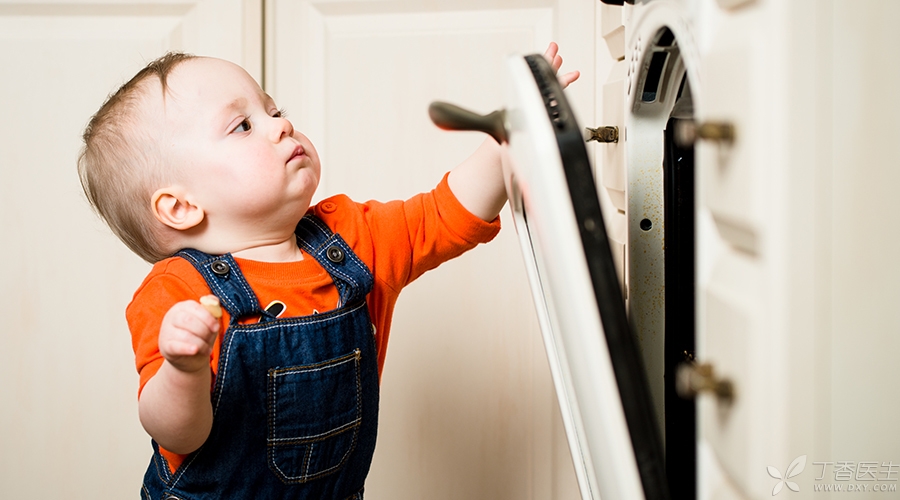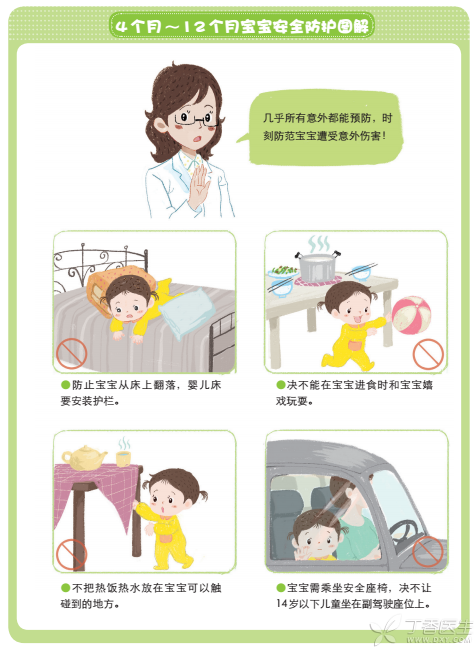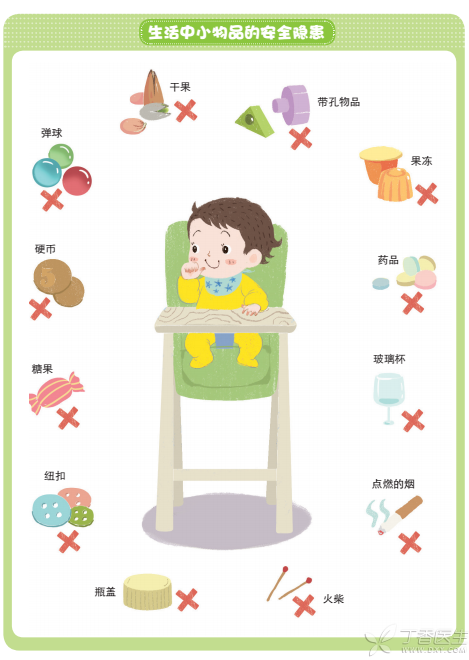
This month-old baby’s great athletic ability has developed rapidly, turning over, sitting alone, crawling, standing and even walking are all concentrated in this period. It also has fine athletic abilities such as grasping with hands and putting what in his mouth.
This adds many potential safety hazards, such as:
- Rolling down from the bed and stairs; Falling from high chairs, windowsills and other places; Injuries caused by knocking on furniture corners or other sharp objects; Sharp instruments such as knives and scissors cut; Electric injuries caused by unprotected power outlets; Hot water and hot rice scald; Burns caused by gas stoves, matches, candles, cigarette butts, etc.; Foreign bodies in trachea caused by toy parts, nuts, beans and other items that can be put into the mouth; There are also accidental injuries caused by drowning, fragile utensils, walkers, etc.
Before turning over,
After the baby will turn over, everyone knows to prevent the baby from rolling down from the bed.
However, parents and caregivers do not know when and when the baby will turn over, so they need someone to watch at all times.
This kind of situation is often encountered in outpatient clinics. When the baby is put on the examination bed, the parents leave to describe the situation to the doctor. Whenever I find the baby lying alone on the examination bed, I will rush to the front of the examination bed like conditioned reflex: [Can’t leave the baby, this is too dangerous! ] [Can’t fall, he can’t climb yet.] My parents are extremely calm. Why am I so rude as a doctor? Because I know that almost all accidents happen under conditions that are considered impossible.
Compared with the crib, the examination bed is high and narrow and has no guardrail. Even if the baby does not turn over, he will twist his body and will inevitably twist to the bedside to lose his center of gravity and fall down. Accidents focus on protection. Of course and lucky psychology are hotbeds for accidents.
When the baby will turn over,
Once the baby can turn over, be sure to let the baby sleep on the bed with guardrails around. If you sleep on tatami or the floor, make sure there are no sharp objects and other dangerous objects around.
Let the baby sleep on an adult big bed without guardrails and use pillows, quilts and parents’ bodies to block it. It can be said that it hides one’s ears and steals the bell. It underestimates the baby’s ability.
Put the baby on a high place, even for a moment or even in a twinkling of an eye, the baby is in danger of falling from a high place.

What put the baby in his mouth.
As the baby grows older, his practical ability increases and his strong curiosity drives the baby to explore, recognize, learn and take risks.
Putting what in your mouth to suck and bite is one of the ways for your baby to know the world.
Therefore, suffocation and poisoning become potential dangers for babies of this age.
However, to prevent the baby from putting what he has in his mouth is to refuse the baby to explore and recognize the world and to curb the baby’s curiosity and desire for knowledge.
What parents and caregivers should do is to keep the baby away from dangerous things and ensure that what the baby gets will not pose danger and harm to the baby when sucking and gnawing in his mouth.
- Nuts, beans, small glass balls and any small items that can be put into the mouth that may cause foreign bodies in the baby’s trachea cannot be easily obtained by the baby. Check whether there are any parts on the toy that are easy to fall off; Drugs and chemicals should be stored out of the reach of the baby. After the baby erupts deciduous teeth, pacifiers and other plastic products are in danger of being bitten down and swallowed into the airway by the baby.
Therefore, if you use pacifiers for your baby, change them frequently to avoid aging and vulnerability of plastic. If the bottle is fed, don’t let the baby play with the pacifier. Remove the bottle immediately after drinking the milk.

A crawling baby
Once the baby can climb, the range of activities will increase. When he has the ability to climb over obstacles and climb to high places with the help of other objects, there is almost no place that the baby cannot reach.
While bringing the baby’s ability development and parents’ joy, it also increases the potential danger. What protection should parents and caregivers do? The above-mentioned fall from a height is still the focus of protection, so there is no need to repeat it here.
- Please ask parents and caregivers to observe the places they go, the things they touch and the things they take from the baby’s angle and vision, and check the possible potential dangers one by one: power sockets and electrical appliances; Poisonous and harmful substances scattered on the ground that can be put into the mouth or small objects that may cause foreign bodies in the trachea; Tea cups and hot water on the tea table; Remote controllers with batteries, especially button cell; Cigarette butts in ashtrays; Scissors, needles and threads placed in drawers and cabinets that are easy to open; Toilets and bathtubs and basins containing water in the toilet; Garbage cans in the kitchen and pots and bowls filled with hot water, hot food, hot soup, etc.
All these need to be kept out of the reach of the baby at all times. You must not take any chances. You think that the baby cannot climb here, even if you climb here, you cannot reach it. Underestimating the baby’s ability is also a potential danger of accidents.
